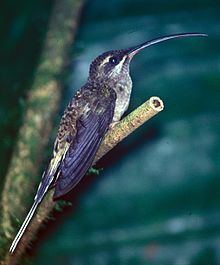Family Trochilidae Scientific name Phaethornis Higher classification Hermit | Infraclass Neognathae Subfamily Phaethornithinae Phylum Chordata Rank Genus Subclass Modern birds | |
 | ||
Lower classifications | ||
Phaethornis is a genus of hummingbirds in the hermit subfamily Phaethornithinae. They occur from southern Mexico, through Central America, to South America as far south as northern Argentina.
Contents
- Long billed hermit phaethornis longirostris interaccions
- Description and ecology
- Taxonomy and systematics
- Species in taxonomic order
- References
Long billed hermit phaethornis longirostris interaccions
Description and ecology
Their plumage typically involves greens, browns, rufous or grey. Most species show some green or bronze iridescence to the upperparts, but this is far less conspicuous than that of many other hummingbirds. The male and female plumages of hermits are very similar, with differences limited to details of bill-shape, tail-shape and/or strength of colours/patterns. No species of hermit show the strong sexual dimorphism usually associated with hummingbirds.
Phaethornis hermits typically have a long decurved bill, although three species, P. koepkeae, P. philippii and P. bourcieri have virtually straight bills. They have a red or yellow base to the lower mandible, and their two central tail feathers are elongated and tipped with white, buff or ochraceous. The crown of the head is flat, and two pale facial stripes enclose a dusky mask.
Most Phaethornis hermits are restricted to the edge and undergrowth of forest, woodland and second growth, but some species (e.g. P. pretrei) also occur in more open habitats.
Many species of hermits form leks and congregate on traditional display grounds, where females visit to choose a mate. However, male hermits are generally less aggressive than other male hummingbirds, though both sexes will defend a feeding territory.
Most hermits are associated with heliconias, but will utilize other nectar sources like flowers of Centropogon, Passiflora, Costus, etc. To a lesser degree, they will capture small arthropods. The long, decurved bills typical of most members of this group of hummingbirds are an adaptation to certain flowers.
Taxonomy and systematics
The taxonomy of some groups have changed significantly in recent years, especially following the split of several small hermits (P. idaliae, P. atrimentalis and P. striigularis) previously considered subspecies of Phaethornis longuemareus, as well as the split of P. longirostris from P. superciliosus.
Further confusion exists between P. superciliosus and P. malaris: Most taxa previously considered subspecies of the former (bolivianus, insolitus, margarettae, moorei and ochraceiventris) are now placerd with the latter. A fully satisfactory taxonomic treatment of the entire longirostris/malaris/superciliosus group is still lacking according to some Neotropical ornithologists.
Another such case is P. maranhaoensis: Some considered it invalid, believing it was the male plumage of P. nattereri. However, P. maranhaoensis only occurs in the northern part of the range of P. nattereri, and the two have different voices. Molecular work also confirms the validity of P. maranhaoensis, though details presently are lacking. Comparably, P. aethopyga has generally been considered invalid as believed to be a hybrid between P. ruber and P. rupurumii, but this assumption has recently been shown to be incorrect, leading to its revalidation as a distinct species. For the same authors, the taxa proposed as hybrids by Hinkelmann, could be valid taxa, especially P. longuemareus imatacae.
